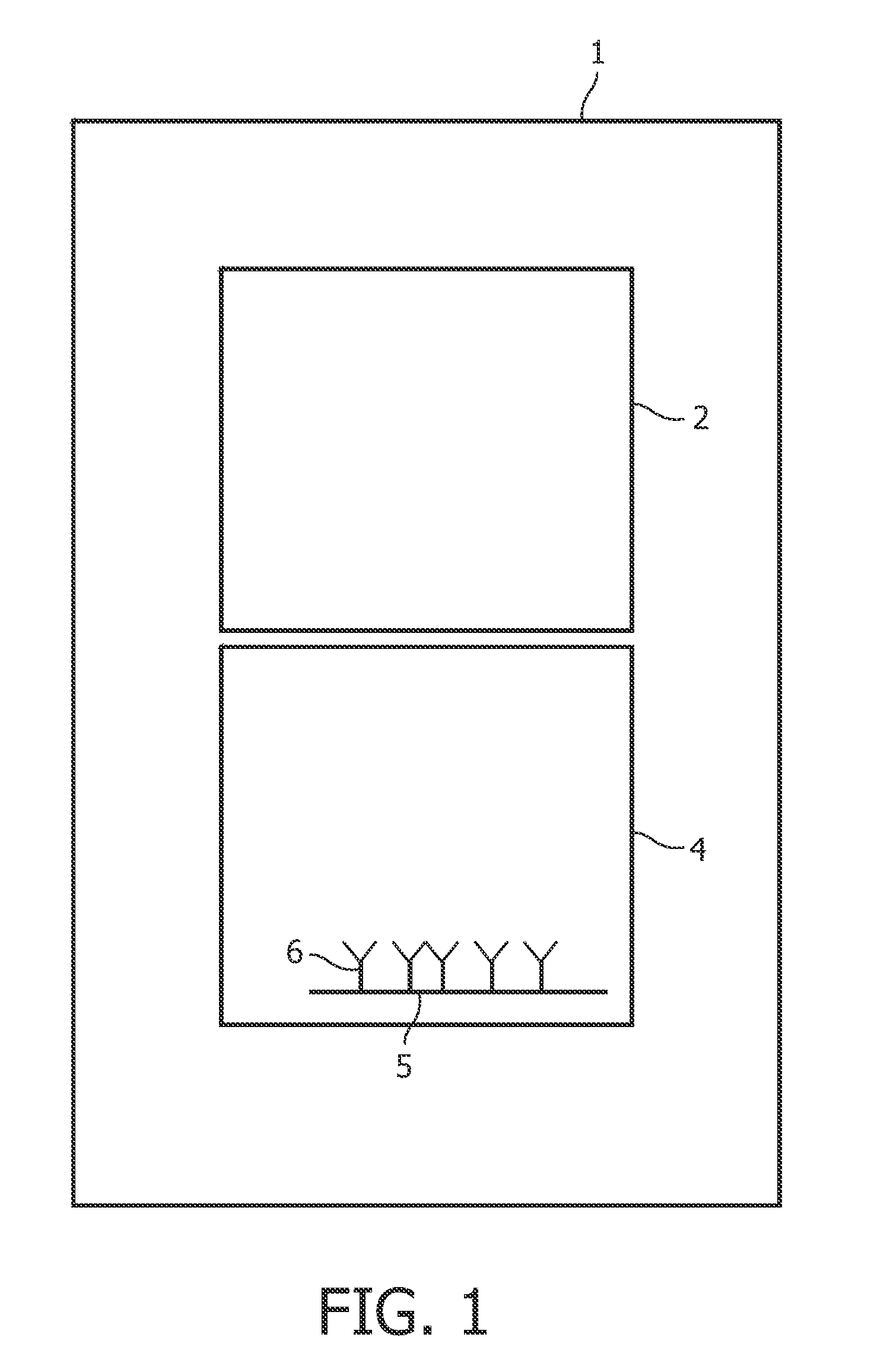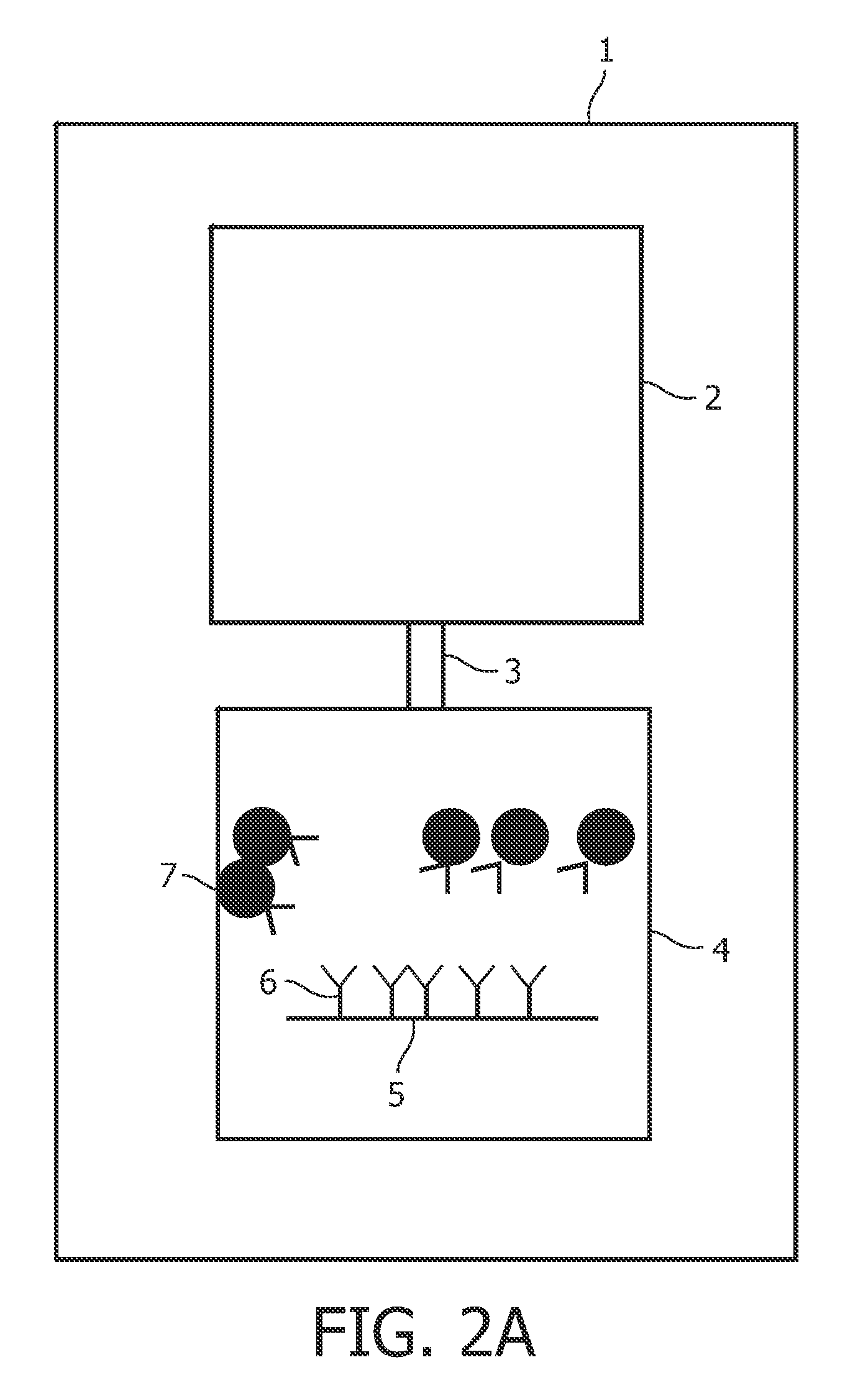Device and methods for detecting analytes in saliva
a technology of analytes and saliva, which is applied in the field of devices and methods for detecting analytes in saliva, can solve the problems of many unsatisfactory tests, interfere with many detection methods, and contain components of saliva, and achieves the effects of less chance of errors, high specificity and sensitivity, and ease of manipulation
- Summary
- Abstract
- Description
- Claims
- Application Information
AI Technical Summary
Benefits of technology
Problems solved by technology
Method used
Image
Examples
example 1
Removal of Interfering Mucin by Repeating the Pre-Treatment Step
[0138]Super paramagnetic beads are coated with a molecule capable of specifically binding an interfering compound of saliva, in this case an anti-mucin antibody. In a first step a saliva sample is contacted with a first pre-treatment region comprising the paramagnetic bead coated with the anti-mucin antibody. By application of a magnetic field the beads are removed from the fluid. The sample is then moved to a second pre-treatment region. The effect of the contacting of the sample with the paramagnetic beads (e.g. the clustering or aggregation status of the superparamagnetic beads caused by the mucins can be monitored during the contacting with the pre-treatment region. This is done by studying the sample, or an aliquot thereof, under a microscope, or for example by using a Nanosizer (Malvern instruments). When aggregation or clustering is observed, the pre-treatment step is repeated (either by applying the sample to a ...
example 2
Rapid Detection of Amphetamines using a Lateral Flow Assay
[0143]A saliva sample is added to a pre-treatment region comprising a sample pad (a porous structure) with anti-mucin antibodies immobilized onto the surface of the sample pad material. The mucins present in the saliva will bind to the immobilized anti-mucin antibodies. The incubation time can be influenced by the size of the sample pad and / or the pore size of the sample pad. The number of immobilized antibodies and the incubation time with the sample pad is adjusted such that the interfering matrix components are sufficiently removed and therefore the a-specific binding or aggregation / clustering of the mobile solid phase is no longer an issue.
[0144]After moving through the pre-treatment zone, the sample transits to a zone where it is contacted with colored particles which are labeled with amphetamine or an amphetamine analogue. The sample then further moves to the detection region, comprising a detection region with anti-amp...
example 3
Detection of Opiate in Assays Making use of HAP Filtration
[0145]Superparamagnetic particles (Ademtech 500 nm COOH coated particles) were coated with monoclonal anti-opiate antibodies. The detection region is prepared by providing a surface coated with BSA-opiate. The top and bottom part of the biosensor was assembled by using tape, and the sensors were kept under lab conditions at room temperature. Four different pre-treatment conditions were used: no pre-treatment, Sponge Bob filter material (Filtrona, density 0.29 g / cm3), and contacting with 50 mg / ml HAP followed by a filter. Next, the particles were redispersed at 0.2 wt % in the pretreated buffer or saliva.
[0146]Samples comprising either assay buffer or 70% saliva (saliva donor 1-3) in assay buffer were subjected to the different pre-treatment regions and subsequently mixed with the magnetizable particles.
[0147]The detection of opiates in samples obtained from the different pre-treatment conditions was performed using a competit...
PUM
| Property | Measurement | Unit |
|---|---|---|
| diameter | aaaaa | aaaaa |
| pore size | aaaaa | aaaaa |
| pore size | aaaaa | aaaaa |
Abstract
Description
Claims
Application Information
 Login to View More
Login to View More - R&D
- Intellectual Property
- Life Sciences
- Materials
- Tech Scout
- Unparalleled Data Quality
- Higher Quality Content
- 60% Fewer Hallucinations
Browse by: Latest US Patents, China's latest patents, Technical Efficacy Thesaurus, Application Domain, Technology Topic, Popular Technical Reports.
© 2025 PatSnap. All rights reserved.Legal|Privacy policy|Modern Slavery Act Transparency Statement|Sitemap|About US| Contact US: help@patsnap.com



